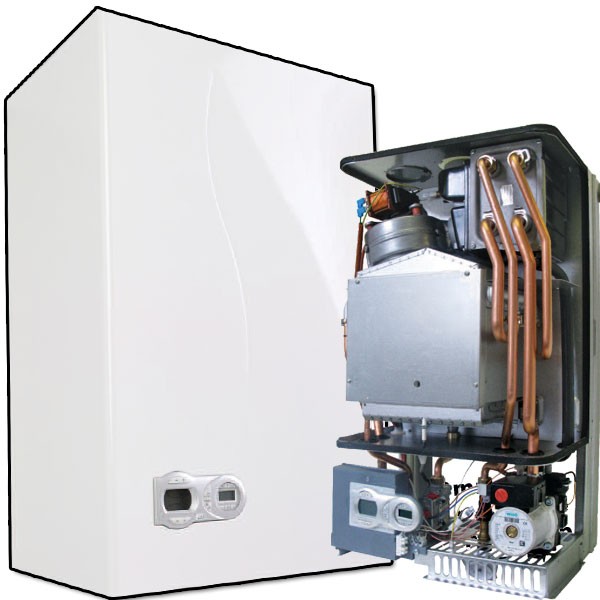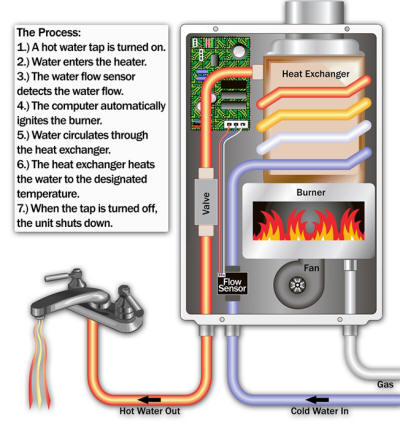Combination Boilers
Combination boiler, or Combi Boiler
You've probably arrived here if you are thinking of having a combi boiler fitted? Well, this is the best-selling boiler type for gas central heating in Britain. Over half of all boilers fitted now are combination boilers. A combination - or 'combi' - boiler provides heat for your radiators and domestic hot water on demand. They have been around for the last 30 years or so, some of the earlier models carry a few horror stories for reliabilty, however modern technology has come on leaps and bounds, especially in the last 10 years.
The name comes from the fact it combines all the functions of a traditional boiler, hot water cylinder and cold water tank set-up. All the major parts are in one unit, which makes them convenient to install.
Please click here for a typical combi boiler installation layout
Typical Combi Boiler |
|---|
There are different types, but they all work by taking cold water straight from the mains supply and heating it as you need it. When you turn on a tap, water is drawn from the mains, heated in the boiler and comes straight out of your tap nice and hot
This means there's no need for a separate hot water storage cylinder or cold water feed cistern. But there's a small time lag between turning on the tap and getting hot water, and the flow rate is limited by how quickly the boiler is able to heat up the water.
The advantage is they require less space than heat-only boilers (because there is no storage cylinder), and avoid heating water that's not used immediately. If you have adequate pressure, you can also run a nice power shower from a combi boiler. You can also put your combination boiler up into the loft space, as it's a sealed system, gravity has less of an effect on the way it works, (whereas a tank fed system has to have the tank at the highest point of the system If there are only one or two occupants living in the house they are ideal.
On the down side, the flow rate limits how much water you can use at one time – no filling the kitchen sink while running a bath, for instance. Also, they can only provide heating, or hot water, not both at the same time, so if you have a large family who showers early on a winters morning, be prepared that your heating will cool down for as long as you're in the shower. Some areas also have very poor mains water flow, so a combination boiler may be least preferred over a tank fed system.
Flow rates and Choosing combi Boiler Size
Combination boilers start off at around 24kW in terms of heat energy, this is sometimes reflected in the model of the boiler i.e. Worcester Greenstar 24i Junior. (We no longer use BTU's as in days gone by to size boilers).
This figure is important as it will be linked directly to its ability to heat your water. You can get a combi boiler with kW ratings in the 40's. Using worcester again as an example, Worcester Greenstar 42Cdi. We no longer size combi boilers on radiator requirments alone, the hot water requirements are more important than anything else. Nearly all combination boilers can cope with heating systems in larger houses.
Worcester Greenstar 24i Junior gives 9.8 litres a minute at 35 degree rise
Worcester Greenstar 42Cdi gives 17.2 litres a minute at 35 degrees rise
You can fill a bath almost twice as quick with a 42kw Worcester than a 24i Junior model. A 100 litre bath would take about 5 and a half minutes to fill with the larger boiler, but just over ten minutes for the smaller model. With power showers, a 24kW may struggle, whereas when you start increasing the output, so does the ability to deliver water to the shower increase.
For people living on their own with low hot water requirements, a 24kW would be ideal. However for a larger family/property, a larger boiler would be required.
Transfer of gas energy to heat hot water |
|---|
Word of Caution
Combination boilers may not be suitable for boiler changes on an old system. They exert a higher water pressure on your central heating system opposed to a tank fed system,, and if you have 'suspect' pipes, valves or radiators, you may get a little wet!!
You might also miss using the (wasted) heat from your hot water cylinder in your airing cupboard. When upgrading from a conventional boiler to a combination boiler, please be aware that the gas pipe may not be large enough. Provision may have to be made to increase the gas pipe, the gas meter may be the other side of the house, this may be a deciding factor in staying with a conventional boiler. Also note, if you have a water meter fitted, you may not like using a combination boiler, as you have to wait slightly longer for consistent hot water than you would using a tank fed system.


